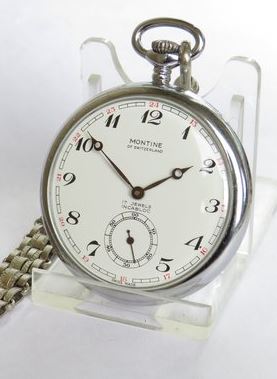Last updated on July 3, 2024
If you collect antique pocket watches for long enough, it is inevitable that you will come across railway-grade pocket watches. In fact, there are collectors out there who focus solely on collecting these types of watches. Personally, I don’t have any real interest in railway history, so I’m not specifically looking to add one to my collection purely on its association with railways. However, I am always looking to collect high-quality antique pocket watches. Railway-grade watches are, by definition, high-quality timepieces. I have no doubt that one day I will add a railway pocket watch to my collection.
Railway grade pocket watches
The railroads provided a steady market for pocket watches made to high specifications, including the number of jewels and adjustments. Jewels are used as bearings on the various moving parts to reduce friction. A watch with no jewels has metal grinding on metal, which gradually causes wear and tear. Eventually, an unjewelled watch is going to lose accuracy and ultimately stop.
Adjustments reflect that the watch has been specially calibrated to keep constant time regardless of position. An adjusted watch could be calibrated in several positions including vertical, horizontal, left, right and upside down.

The exact specifications would vary according to each country. However, the typical railway pocket watch in the early 20th century satisfied the following requirements:
An open-faced dial, with the stem at 12 o’clock.
A minimum of 17 functional jewels in the movement.
A maximum variation of 30 seconds (approximately 4 seconds daily) per week.
The watch must be adjusted to at least five positions.
The watch would be adjusted for temperature variance and isochronism (variance in spring tension).
Bold legible Arabic numerals would be used to indicate the time, typically black numerals on a white dial.
A lever would be used to set the time. This limits the risk of inadvertently setting the watch to the wrong time when winding the watch with the stem.
The watch would use a Breguet balance spring with a micrometer adjustment regulator.
Railway time
Railroads were at the forefront of the effort to standardise timekeeping in the late 1800s. This was because if the watches of the engineers weren’t accurately synchronized, collisions could result. The first standardised time arrangement was applied by the Great Western Railway in England in November 1840. The agreement synchronised the different local mean times into a single standard time. This became known as railway time. It was adopted by all railway companies across Great Britain over the following seven years. The timetables by which trains were scheduled and the time station clocks displayed were brought in line with the local mean time for London or Greenwich Mean Time (GMT).
Before the widespread use of the electric telegraph, stationmasters adjusted their clocks using tables supplied by the railway company to convert local time to London Time. In turn, train guards set their chronometers against those clocks. The electric telegraph, which had been developed in the early part of the 19th century, began to be used as a means to transmit the London time in 1839. By 1852 a telegraph link had been constructed between a new electromagnetic clock at Greenwich and initially Lewisham, and shortly after this London Bridge stations. By 1855, time signals from Greenwich could be sent through wires alongside the railway lines across the length and breadth of Britain.
Kipton train crash
On April 18th 1891, an express mail train of the Lake Shore and Michigan Southern Railway was involved in a head-on collision with a passenger train heading in the opposite direction. The two trains collided near Kipton, Ohio. Nine people were killed in the accident. The passenger train should have pulled into a siding to let the faster train pass. However, an engineer’s watch had stopped and the passenger train was late pulling into the siding. The crash triggered a chain of events that would have a significant impact on the standards of timekeeping in the railroad industry.
In the aftermath of the crash, the Board of the Railroad Company appointed Webster Clay Ball (1848 – 1922), a watchmaker and jeweller from Cleveland, Ohio, to investigate the incident. Ball was appointed as the Chief Time Inspector and he established precision standards for railroad chronometers.
Related content
Railroad chronometer at Wikipedia.
Railway time at Wikipedia.

Would I be correct in assuming that antique railway pocket watches would be of interest to collectors because of their high standards in timekeeping? Does that reflect in their value?
Hi Mike, yes the quality of the movements and the timekeeping of antique railway pocket watches could certainly appeal to some collectors. They could also appeal to collectors of general railway memorabilia. The quality of the movement, the timekeeping and the association with the railways all influence the value of an antique watch. However, we aren’t talking about life changing amounts. Thanks for taking the time to comment, Jason